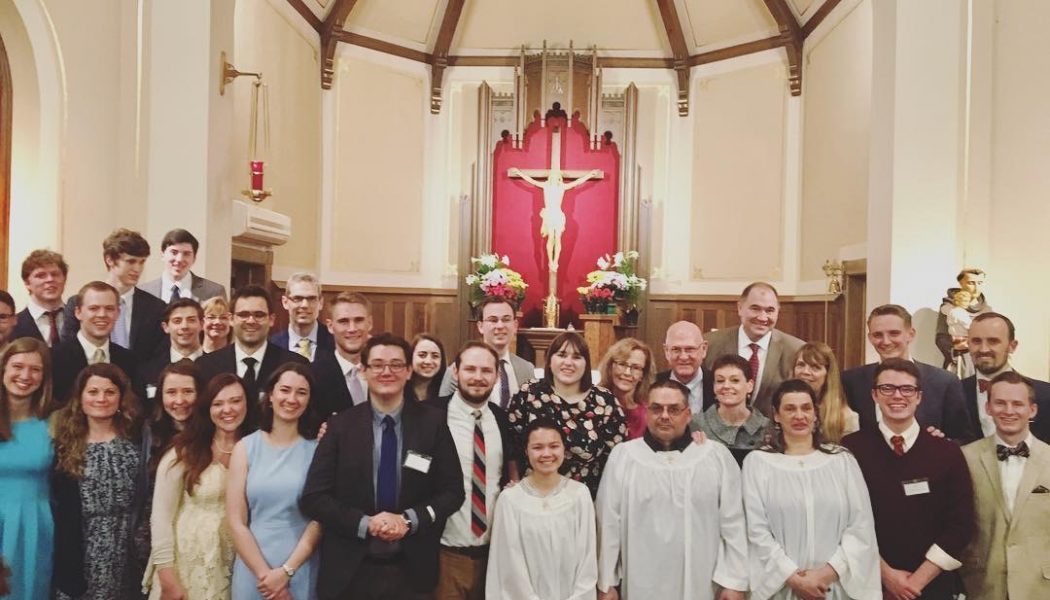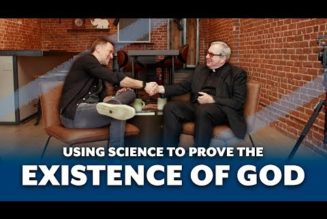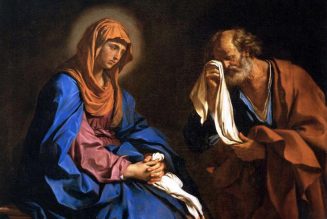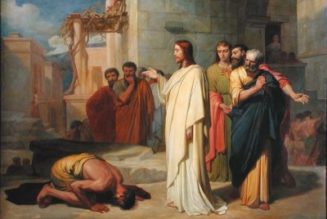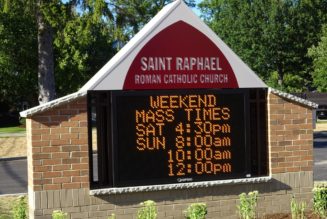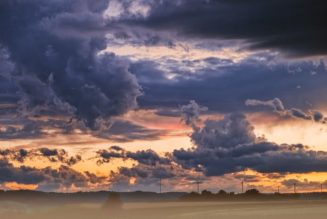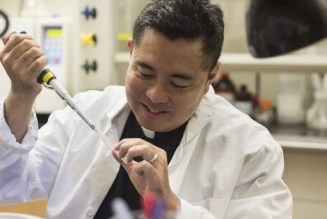
At a college where more than 90% of students actively practice a religion and where debates about transubstantiation versus consubstantiation, the significance of Christ’s incarnation, and, most contentiously, Mary’s perpetual virginity echo through the halls, Catholicism seems to be gaining new ground.
Between 2016 and 2019, 76 people converted to Catholicism at St. Anthony of Padua Catholic Church and were confirmed after undergoing the Rite of Christian Initiation of Adults. Many of them were Hillsdale students. In 2019 alone, 12 out of 24 converts were Hillsdale students.
Nationally, the percentage of Catholics declined from 24% to 21% of the population since 2014. Approximately 2% of U.S. adults identify as Catholic converts, according to a PEW Research Center survey in 2018. At Hillsdale, 26% of the student body identifies as Catholic according to a 2018 Collegian survey.
Though national Catholicism is on the decline, Catholicism at Hillsdale is clearly growing.
Based on their personal experiences, nine recent Catholic converts cited three major factors that impacted their theological beliefs and led to their conversion while at Hillsdale: a unique blend of passionate and respectful theological conversation, a community of devoted Catholics, and Hillsdale’s focus on classical liberal arts and the Western tradition.
Sophomore Shelby Dorman currently attends RCIA classes and intends to join the Catholic Church at Easter. Her interest in Catholicism began with questions about transubstantiation and the incarnation, but before coming to Hillsdale, she said she didn’t think about becoming Catholic or even know anyone who practiced Catholicism.
Encountering people of sincere faith from all different denominations at Hillsdale helped Dorman begin to process the questions that had been simmering in the back of her mind since high school.
“When I went to Hillsdale, I held a lot of classic stereotypes against Catholics,” Dorman said. “I think there were a lot of barriers in my mind because of incorrect things I had heard. So having those lies torn down, I was able to see some truth in there.”
Friends opened a door that Dorman hadn’t even recognized before, and, “after a lot of angst,” she began attending RCIA. Dorman emphasized that, despite fears about how her Protestant friends would react, they were all supportive.
Junior Grace Mauck is in the process of converting and agreed with Dorman.
“The main thing is just how open people are to talking about their faith. When people try to convert you, it is off-putting and offensive, like they don’t respect your own faith,” Mauck said. “I never felt that way. It was more that people here wanted to tell me how they loved, worshipped, and prayed to God.”
St. Anthony’s Catholic Church is also uniquely attractive to converts. Senior Claire Calvert and her father, Kenneth Calvert, a professor of history, live in Hillsdale and converted as a family. Claire Calvert’s older brother forged the path, then she, her parents, and her younger brother followed suit. Though Claire Calvert began the conversion process before enrolling at Hillsdale College, she said that St. Anthony’s plays a special role in the Catholic community at Hillsdale and in her conversion.
“Anyone I have talked to who comes and goes from Hilldale says that St. Anthony’s is so different and so special,” Claire Calvert said. “It is hard to pinpoint what it is. It’s Father David, it’s the local families, it’s a conglomeration of all these people who really have a passion for their faith and a love for this tiny little church in the middle of nowhere. It somehow draws you in and you feel this presence of God and a welcoming spirit.”
Rev. David Reamsnyder, pastor at St. Anthony’s and convert to Catholicism himself, emphasizes rich theological understanding and scriptural teaching in his weekly homilies, which, according to Dorman, is very comforting and familiar to Protestant listeners.
Many converts are uncomfortable with the word “conversion” to describe their entrance into the Catholic Church. Rather, they see it as another step in their perpetual journey toward Christ.
Junior Isaac Kirshner, also in the process of converting, especially took offense to calling his faith journey a “conversion.”
“I have always loved Jesus,” Kirshner said. “I don’t worship a different Christ now, but through his church, a fuller Christ. I mean that he has so radically illumined more of himself to me and has blessed me with a deeper desire to love Him more. Conversion, for me, has been the daily turning of my heart toward the heart of Christ, which is love.”
Both Kenneth Calvert and his daughter stressed that Protestantism was crucial in their faith formation and played a key role in their journey toward Christ.
“From ages 5 to 18, I went to St. Paul’s Lutheran Church just outside of town. It was the first place where I learned catechism and church doctrine and where I began to form an appreciation for having a strong spiritual life,” Claire Calvert said. “There was a real beauty in the service that I still to this day appreciate.”
Kirshner, Mauck, Dorman, Claire Calvert, and senior Phil Bernston, President of the Catholic Society, all said they experienced an intellectual conversion before their hearts turned to Catholicism. More than a place for religious beliefs to intermix and percolate in discerning minds, Kirshner said his experience at Hillsdale was a journey toward intellectual orthodoxy and true conservatism.
“For me, becoming traditionally conservative made me consider Catholicism,” Kirshner said. “The idea that we should conserve what we have been handed down and not just do away with the wisdom of the ages. No, truth is truth a thousand years ago the same as it is today.”
Reading Nathaniel Hawthorne’s “Earth’s Holocaust” in American Heritage marked a shift in Kirshner’s understanding of the extra-liturgical.
“In the story, the townspeople burn a crucifix and books and other accoutrements of religion because they say desire to get to the pure, simple faith by doing away with all that seems extra,” Kirshner said. “But as you read it, you realize that all that had been passed down is actually your pure and simple faith. They burned everything they have been given, and they end up with nothing.”
For Bernston, a 2019 convert, Western Heritage and Great Books classes piqued his curiosity about church history.
“I never really understood historical Christianity until I came to Hillsdale,” Bernston said. “Western Heritage, and really the whole core, lends itself to conversion because you start reading the great thinkers of the faith — Augustine, Aquinas, and the church fathers — and I was amazed that I had not learned any of this stuff.”
Mauck said Aquinas, Augustine, and Dante, in particular, led her to question the relationship between scripture, tradition, and the historical church.
“I was reading these books of the Western canon that really focus on God and I was exposed to so much more understanding that really spoke to me on a spiritual and intellectual level,” Mauck said. “I started to notice that before I became familiar with the Catholic Church, I didn’t give credence to how many intellectual ideas went into the church and how beautiful that really was.”
Though Mauck and many of her fellow converts first experienced an intellectual conversion, she said her heart stubbornly resisted her reason. One of the biggest problems for Mauck, and also for Kirshner, Dorman, and Claire Calvert, was Catholic doctrine about Mary. She said over the course of a few months she could not stop thinking about Mary and how she fit into the church. Mauck stumbled into conversations about Mary all over campus, caught herself thinking about her all the time, and even dreamed about her often.
But Mauck’s biggest roadblock into the church transformed into a serious drive toward conversion.
“I am so blessed because I genuinely believe that Mary came to me,” Mauck said. “My best friend is a devout Catholic and I told her what I was going through and I was like, ‘I think I need to pray the rosary.’ So she taught me what to do and we started praying it and I just broke down in tears because I felt so much of her presence around me and that was it. From that moment, I was like, ‘I need to join the church.’”
While conversions are exciting for Catholics in Hillsdale’s small community, given the decline of Catholicism in the U.S., Kenneth Calvert emphasized the global trend of Catholic resurgence. The Catholic News Agency reported a 17.8% increase in Catholicism globally. Because Hillsdale is a relatively small college campus, students and faculty can see the effects of the Catholic resurgence more personally.
Claire Calvert said this is one of her favorite parts about Hillsdale’s spiritual community.
“It is not just a Hillsdale thing,” she said. “It is just the will of God working here and everywhere else. I think it is a beautiful thing because it is such a small community that we can really see it happening in people that we know really well and care about very much.”
Mauck said her experience of conversion at Hillsdale was multi-faceted. Though discussions, classes, and professors played a role, she ultimately placed the credit far above the earthly.
“I just think God’s presence is so clear at Hillsdale. I have never been in a place where I feel the Lord’s presence all the time,” Mauck said. “I don’t think it is a coincidence that there are so many conversions here. I think it is because the Holy Spirit is so present here. It is really beautiful.”
